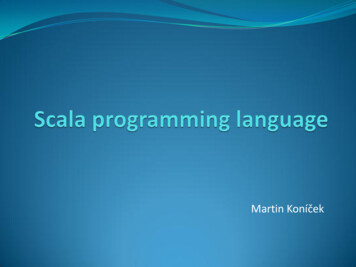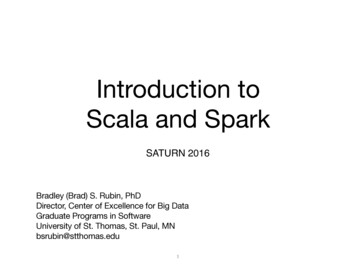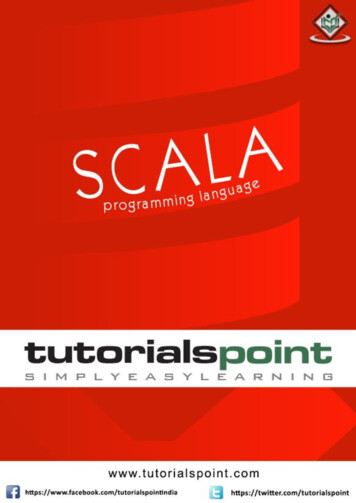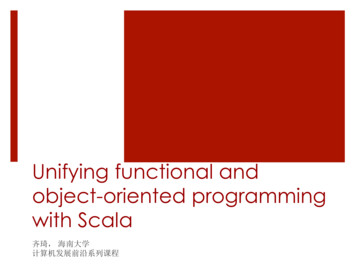
Transcription
Introduction to ScalaKenny Zhuo Ming LuSchool of Information Technology, Nanyang PolytechnicOctober 9, 2017Kenny Zhuo Ming LuIntroduction to Scala
Learning outcomesBy the end of this lecture, you will have some basic understandingonObject Oriented Programming in ScalaFunctional Programming in ScalaAlgebraic data type and pattern matchingHigher order functionsPartial functionsImplicit functionsType classesMonadsData parallelism in ScalaConcurrent programming in Scala with threads and actorsKenny Zhuo Ming LuIntroduction to Scala
Scala is .A general purpose programming language that isObject Oriented and Functionalwith distributed programming builtinwith a rich type system and a huge set of libraries andeco-systemsWidely used in academic research projects (e.g. Spark wasfrom UC Berkeley) and industries (e.g. Scalding from Twitter,Kakfa from Linkedin, Coursera Walmart, . )Kenny Zhuo Ming LuIntroduction to Scala
Hello World in a scriptLet’s say we have a Scala file Script.scalaprintln("Hello world!")To execute it scala Script.scalaHello world!Kenny Zhuo Ming LuIntroduction to Scala
Hello World in a console applicationCompiling Scala program into an applicationobject Main extends App{println("Hello world!")}object is like a singleton class.To execute it scalac Main.scala scala MainHello world!Kenny Zhuo Ming LuIntroduction to Scala
Object Oriented Programming in ScalaIt is very similar to Javaclass Person(n:String,i:String) {private val name:String nprivate val id:String idef getName():String namedef getId():String id}Person is the name of the class,Person(n:String,i:String) is a constructor.private sets the accessibility scope of the membersval introduces a value, (immutable variable)def introduces a method defintion.Kenny Zhuo Ming LuIntroduction to Scala
Object Oriented Programming in ScalaClass Inheritence via the extends keywordclass Student(n:String, i:String, g:Double)extends Person(n,i) {private var gpa gdef getGPA() gpadef setGPA(g:Double) {gpa g}}var introduces a mutable variableMost of the type annotations are optional and will be inferredby the type system.Kenny Zhuo Ming LuIntroduction to Scala
Object Oriented Programming in Scalaclass Staff(n:String, i:String, sal:Double)extends Person(n,i) {private var salary saldef getSalary() salarydef setSalary(sal:Double) {salary sal}}Kenny Zhuo Ming LuIntroduction to Scala
Object Oriented Programming in ScalaTraits are like Java interfaces and abstract classestrait NightOwl {def stayUpLate():Unit}class Student(n:String, i:String, g:Double)extends Person(n,i) with NightOwl {private var gpa gdef getGPA() gpadef setGPA(g:Double) {gpa g}override def stayUpLate():Unit {println("woohoo")}}Kenny Zhuo Ming LuIntroduction to Scala
Running our first Scala programScala comes with an interpretor (AKA REPL)scala :load OOP.scalaLoading OOP.scala.defined class Persondefined trait NightOwldefined class Studentdefined class Staffscala val tom new Student("Tom", "X1235", 4.0)tom: Student Student@601c1dfcscala val jerry new Staff("Jerry", "T0001", 500000.0)jerry: Staff Staff@650fbe32scala tom.stayUpLatewoohooKenny Zhuo Ming LuIntroduction to Scala
Functional Programming in ScalaOOP is useful, but often less interesting, let’s consider the FPfeatures in Scala.Image taken from alaKenny Zhuo Ming LuIntroduction to Scala
Algebraic Data TypeIn Scala, this is how we define a data typesealed trait Expcase class Val(v:Int) extends Expcase class Plus(e1:Exp, e2:Exp) extends Expdef simp(e:Exp):Exp e match {case Val(v) ecase Plus(Val(0), e2) e2case Plus(e1,e2) Plus(simp(e1), simp(e2))}sealed requires all extensions to the trait Exp must bedeclared in the same module.case makes a class “pattern-matchable”Kenny Zhuo Ming LuIntroduction to Scala
Algebraic Data TypeIn Java, to achieve the above we have to use abstract class andmethod overriding. (For brevity, setter and getter methods areomitted.)public abstract class Exp { public abstract Exp simp(); }public class Val extends Exp {private int v;public Val(int v) { this.v v; }public Exp simp() { return this; }}public class Plus extends Exp {private Exp e1; private Exp e2;public Plus(Exp e1, Exp e2) {this.e1 e1; this.e2 e2;}public Exp simp() {if (e1 instanceof Val) {Val v1 (Val)e1;if (v1.getV() 0) { return e2; }}return new Plus(e1.simp(),e2.simp());}}Kenny Zhuo Ming LuIntroduction to Scala
ListAlgebraic data type and pattern matching are useful in case ofhandling recursive/nested data structures, e.g. a linked list.sealed trait List[A]case class Nil[A]() extends List[A]case class Cons[A](x:A, xs:List[A]) extends List[A]val x Cons(1,Cons(2,Nil()))def length[A](l:List[A]):Int l match {case Nil() 0case Cons( ,xs) 1 length(xs)}ObservationA is a type variable (AKA generics)Parametric polymorphismNil() takes no argument, it’s always (almost) singleton.Kenny Zhuo Ming LuIntroduction to Scala
ListMixing subtying with parametric polymorphismsealed trait List[ A]case object Nil extends List[Nothing]case class Cons[A](x:A, xs:List[A]) extends List[A]val x Cons(1,Cons(2,Nil))def length[A](l:List[A]):Int l match {case Nil 0case Cons( ,xs) 1 length(xs)}case object introduces a singleton value constructor. indicates that A is a covariant type parameter, henceList[Nothing] : List[A] for any A .Nothing is the bottom type in the sub-typing hierachy.Kenny Zhuo Ming LuIntroduction to Scala
ListList is a builtin data type comes with Scala libraryval x List(1,2)def length[A](l:List[A]):Int l match {case Nil 0case ( ::xs) 1 length(xs)}which is equivalent to the following Haskell programx [1,2]length :: [a] - Intlength l case l of[] - 0( :xs) - 1 length xsKenny Zhuo Ming LuIntroduction to Scala
List Comprehensionval nats:List[Int] List(1,2,3,4)val even plus 1:List[Int] for (nat - natsif nat % 2 0) yield (nat 1)for . yield denotes a sequence comprehension.C.f. set builder notation in math,{nat 1 nat nats nat mod 2 0}Kenny Zhuo Ming LuIntroduction to Scala
For loop vs comprehensionNote that for . yield denotes a sequence comprehension.val nats:List[Int] List(1,2,3,4)val even plus 1:List[Int] for (nat - natsif nat % 2 0) yield (nat 1)While for introduces a for loop.for (i - 1 to 10) { println(i) }prints the numbers 1 to 10.for (nat - nats if nat % 2 0) { println(nat) }prints the numbers 2 and 4.Kenny Zhuo Ming LuIntroduction to Scala
List operationsLengthval l1 List(1,2,3)val len l1.length // 3Concatenationval l2 List(-1,-2,-3)val l3 l1 l2 // List(1,2,3,-1,-2,-3)Reverseval l4 l1.reverse // List(3,2,1)Kenny Zhuo Ming LuIntroduction to Scala
List operationsmin/max// recall l1 List(1,2,3)val min l1.min // 1val max l1.max // 3sorting// recall l3 List(1,2,3,-1,-2,-3)val sl3 l3.sortWith( ) // List(-3, -2, -1, 1, 2, 3)// we will look into in a short while.sub-listval sl3a sl3.take(3) // List(-3,-2,-1)val sl3b sl3.drop(3) // List(1,2,3)Kenny Zhuo Ming LuIntroduction to Scala
Map and Foldl.map(f) returns a new list by applying the unary function f toeach element in lval l List(1,2,3,4)val l2 l.map(x x * 2) // List(2,4,6,8)Note that x x * 2 is a lambda-expression, which can beshortened as * 2. The . is optional.val l2 l map ( *2)which is equivalent to the following Haskell programl [1,2,3,4]l2 map (\x - x*2) lKenny Zhuo Ming LuIntroduction to Scala
Map and Foldl.foldLeft(b)(f) agreggate all the elements in l with thebinary function f and the base value b.// recall l List(1,2,3,4)val l3 l.foldLeft(0)((x,y) x y)In essence the above is computing(((0 1) 2) 3) 4l.foldRight(b)(f) agreggate all the elements in l with thebinary function f and the base value b with right associativity.val l4 l.foldRight(0)((x,y) x y)// or val l4 l.foldRight(0)( )In essence the above is computing1 (2 (3 (4 0))))Kenny Zhuo Ming LuIntroduction to Scala
Higher order functionThe defintion of map.sealed trait List[ A] {def map[B](f:A B):List[B] this match {case Nil Nilcase x::xs f(x)::xs.map(f)}}case object Nil extends List[Nothing]case class Cons[A](x:A, xs:List[A]) extends List[A]Function f:A B is used as a formal argument.Equivalently, in Haskell, we have.map :: (a - b) - [a] - [b]map f [] []map f (x:xs) (f x):(map f xs)Kenny Zhuo Ming LuIntroduction to Scala
Higher order functionFunction compositionval l1 List(1,2,3)val l2 l1.map (((x:Int) x*2) compose (y y 1))// List(4, 6, 8)(f compose g)(x) is equivalent to f(g(x))val l3 l1.map (((x:Int) x*2) andThen (y y 1))// List(3, 5, 7)(f andThen g)(x) is equivalent to g(f(x))Kenny Zhuo Ming LuIntroduction to Scala
Higher order functionIn Scala, functions are instances/objects of trait FunctionThe defintions of compose and andThen.object Function { // this is like a packagetrait Function1[ A][-B] {def apply(x:A):B {.}// apply() gives us// the syntactic sugar form like f(x)def compose[C](that:C A):C B (c:C) this(that(c))def andThen[C](that:B C):A C (a:A) that(this(a))}}Both compose and andThen return functions as results.Kenny Zhuo Ming LuIntroduction to Scala
Functions vs methodsIn Scala there is a clear distinction between functions andmethods.Methods are introduced by def keyword, e.g.scala def f(x:Int) xf: (x: Int)IntFunctions are implementations of the FunctionX traits. e.g.lambda expressions are functions.scala val g (x:Int) xg: Int Int function1 Simiilarity: both can be used as argument and resultsscala List(1,2).map (f) List(1,2).map (g)res2: Boolean trueKenny Zhuo Ming LuIntroduction to Scala
Functions vs methodsIn Scala there is a clear distinction between functions andmethods.Difference: methods do not possess combinatorsscala f compose g console :10: error: missing arguments for method f;follow this method with ‘ ’ if you want to treat itas a partially applied functionf compose g scala g compose fres1: Int Int function1 To convert a method to a function.scala fres1: Int Int function1 Kenny Zhuo Ming LuIntroduction to Scala
Before we take a break.Let’s play some quiz games. Open the web browser in your mobile,tablet or laptop.visit http://kahoot.itkey in the game pin, thenkey in your name, please use real name to claim the prize.Kenny Zhuo Ming LuIntroduction to Scala
Before we take a break.Kenny Zhuo Ming LuIntroduction to Scala
Partial functionsThere are situations in which we need to deal with partialfunctions, naturally, we can use the Option type in Scala (similarto the Maybe type in Haskell).def div(x:Int)(y:Int):Option[Int] if (y 0) None else Some(x/y)}{val xs List(0,1,2) map (x div(2)(x))yields List(None, Some(2), Some(1))val ys xs filter (x x.nonEmpty)yields List(Some(2), Some(1))val zs ys map ( x x match { case Some(y) y } )yields List(2,1)Kenny Zhuo Ming LuIntroduction to Scala
Partial functionsAlternatively, we may use the Scala bultin PartialFunctiondef div(x:Int): PartialFunction[Int,Int] {case (y:Int) if y ! 0 x/y}val xs List(0,1,2) collect ( div(2) )yields List(2, 1).Note that we have to use the collect method instead of mapval ys List(0,1,2) map ( div(2) )Will result in a scala.MatchErrorKenny Zhuo Ming LuIntroduction to Scala
Partial functionsorElse allows us to compose partial functions which arecomplimenting on their domains.def div(x:Int): PartialFunction[Int,Int] {case (y:Int) if y ! 0 x/y}val mkZero: PartialFunction[Int,Int] {case (y:Int) if y 0 0}val ys List(0,1,2) map ( div(2) orElse mkZero )yields in a List(0, 2, 1)Kenny Zhuo Ming LuIntroduction to Scala
Implicit functionsImplicit function and implicit parameter allow us to define defaultbehaviors.implicit def logger(mesg:String):Unit {println("[Log] " mesg)}def fib(x:Int)(implicit log:String Unit):Int {x match {case 0 0case 1 1case {log("computing fib(" x ")")fib(x-1) fib(x-2)}}}Kenny Zhuo Ming LuIntroduction to Scala
Implicit functionsscala fib(5)[Log] computing fib(5)[Log] computing fib(4)[Log] computing fib(3)[Log] computing fib(2)[Log] computing fib(2)[Log] computing fib(3)[Log] computing fib(2)res7: Int 5scala fib(5)( x Unit)res8: Int 5Kenny Zhuo Ming LuIntroduction to Scala
Implicit functionsScala resolves implicit parameters as follows,1 Search in current scope1232Implicits defined in current scopeImplicits defined in Explicit importsImplicits defined in wildcard importsSearch for associated types in1234Companion objects of a typeImplicit scope of an argument’s typeOuter objects for nested typesOther dimensionsKenny Zhuo Ming LuIntroduction to Scala
Type classesType classes was introduced in Haskell to allow mixing parametricpolymorphism and ad-hoc polymorphism.Haskell Type Class Exampleclass Eq a where( ) :: a - a - Boolinstance Eq Int where( ) x y eqInt x yinstance Eq a Eq [a] where( ) [] [] True( ) (x:xs) (y:ys) (x y) && (xs ys)( ) Falsecheck :: (Eq [a]) [a] - [a] - Boolcheck xs ys xs ysKenny Zhuo Ming LuIntroduction to Scala
Type classesIn Scala, type classes are “encoded” using traits and implicitdefinitions, i.e. implicit val, implicit def and implicitobjecttrait Eq[A] { def eq(x:A,y:A):Boolean }implicit val eqInt new Eq[Int] {def eq(x:Int,y:Int):Boolean x y}implicit def eqList[A](implicit ev:Eq[A]) new Eq[List[A]] {def eq(xs:List[A],ys:List[A]):Boolean (xs,ys) match {case (Nil,Nil) truecase (x::xs2, y::ys2) ev.eq(x,y) && eq(xs2,ys2)case ( , ) false}}Kenny Zhuo Ming LuIntroduction to Scala
Type classesBy resolving implicit parameter the compiler builds the “evidence”ev AKA the dictionary.def check[A](x:List[A], y:List[A])(implicit ev:Eq[List[A]]) ev.eq(x,y)scala check(List(1,2,3), List(1,2,3))res6: Boolean trueThe above builds the evidence ev eqList(eqInt)Kenny Zhuo Ming LuIntroduction to Scala
Type classesTo mimick type classes’ effect in OOP languages like Java, wewould have to use interface and function overriding with lots ofcares. (We omit the getter and setter methods for brevity.)public interface Eq T { public boolean eq(T that); }public class Int implements Eq Int {private int val;public Int(int x) { val x; }public boolean eq(Int that) {return (val that.getVal());}}public class List T extends Eq T implements Eq List T {private Node T pHead;public List() { pHead null;}public void insert(T v) {Node T n new Node T (v);n.setNext(pHead);pHead n;}public boolean eq(List T that) {return pHead.eq(that.getPHead());}}Kenny Zhuo Ming LuIntroduction to Scala
Type classesTo mimick type classes’ effect in OOP languages like Java, wewould have to use interface and function overriding with lots ofcares. (We omit the getter and setter methods for brevity.)public class Node T extends Eq T implements Eq Node T {private T val;private Node T next;public Node(T v) {val v;next null;}public boolean eq(Node T that) {if (!val.eq(that.getVal())) { return false; }else {if ((next null) && (that.getNext() null)) { return true; }else if ((next null) && (that.getNext() ! null)) { return false; }else if ((next ! null) && (that.getNext() null)) { return false; }else { return next.eq(that.getNext()); }}}}Kenny Zhuo Ming LuIntroduction to Scala
Type classesTo mimick type classes’ effect in OOP languages like Java, wewould have to use interface and function overriding with lots ofcares.Finally we can implement the check function in Java as follows,public static T extends Eq T boolean check(List T l1, List T l2) {return l1.eq(l2);}Kenny Zhuo Ming LuIntroduction to Scala
Type classesFor real world applications implemented in Scala, we do not defineall the type classes from the scratch. We use a library projectcalled scalaz. https://github.com/scalaz/scalaz whichprovides many useful type classes.Kenny Zhuo Ming LuIntroduction to Scala
MonadsA vague analogyAlgebraic data types define abstractions of run-time data (orvalues), i.e. what are the possible values.Monads define abstractions of computations, i.e. what thepossible computations.So what are monads good for?segregating pure computation from computation withside-effect, (i.e. i/o)capture program control flowgeneric data traversaldefine user-programmable states and transitionscompose computationsKenny Zhuo Ming LuIntroduction to Scala
Monad example: Safe Integer arithmeticsLet’s model safe arithmetic computationsealed trait SafeVal[ T]case class Val[T](x:T) extends SafeVal[T]case class Err(msg:String) extends SafeVal[Nothing]type SafeInt SafeVal[Int]Kenny Zhuo Ming LuIntroduction to Scala
Monad example: Safe Integer arithmeticsdef add(x:SafeInt, y:SafeInt):SafeInt x match {case Err(msg) Err(msg)case Val(i) y match {case Err(msg) Err(msg)case Val(j) Val(i j)}}def div(x:SafeInt, y:SafeInt):SafeInt x match {case Err(msg) Err(msg)case Val(i) y match {case Err(msg) Err(msg)case Val(j) {if (j 0) {Err("div by 0")} else {Val (i/j)}}}}Kenny Zhuo Ming LuIntroduction to Scala
Monad example: Safe Integer arithmeticsWe spot many similar code structure, let’s rewrite them in terms ofsome higher order combinators pnt and bnd.def pnt[A](x: A):SafeVal[A] Val(x)def bnd[A,B](sa: SafeVal[A])(f: A SafeVal[B]): SafeVal[B] sa match {case Err(msg) Err(msg)case Val(a) f(a)}Note that x: A defines a lazy formal parameter x of type A.pnt “lifts” / “injects” a value into the SafeVal object.bnd “composes” the previous SafeVal with the subsequentcomputation.Kenny Zhuo Ming LuIntroduction to Scala
Monad example: Safe Integer arithmeticsdef add(x:SafeInt, y:SafeInt):SafeInt {bnd(x)(x1 {bnd(y)(y1 pnt(x1 y1))})}def div(x:SafeInt, y:SafeInt):SafeInt {bnd(x)( x1 {bnd(y)( y1 {if (y1 0) { Err("div by 0") }else { pnt(x1 / y1) }})})}Kenny Zhuo Ming LuIntroduction to Scala
Monad example: Safe Integer arithmeticsIf we use type classes Monad and MonadPlus provided by scalaz,we can make it even more concise.implicit object safeValMonadPlusextends MonadPlus[SafeVal] {override def point[A](a: A):SafeVal[A] Val(a)override def bind[A, B](sa: SafeVal[A])(f: A SafeVal[B]): SafeVal[B] sa match {case Err(msg) Err(msg)case Val(a) f(a)}.}Kenny Zhuo Ming LuIntroduction to Scala
Monad example: Safe Integer arithmeticsdef add(x:SafeInt,y:SafeInt):SafeInt {for ( x1 - x; y1 - y) yield (x1 y1)}def div(x:SafeInt,y:SafeInt):SafeInt {for ( x1 - x; y1 - y; if y1 ! 0) yield (x1 / y1)}Roughly speaking, for (x - e1 ; e2) is desugared tobind(e1)(x e2)Kenny Zhuo Ming LuIntroduction to Scala
Monad example: Matrix multiplicationGivenval l1 List(1,2,3)val l2 List(’a’,’b’)We want to define the matrix multiplication multscala mult(l1,l2)res0: List[(Int, Char)] List((1,a), (1,b), (2,a), (2,b),(3,a),(3,b))def mult[A,B](as:List[A], bs:List[B]):List[(A,B)] {as flatMap ( a bs map ( b (a,b) ))}Note List(List(1),List(2)).flat yields List(1,2). flatMapis defined as the composition of flat and map.Kenny Zhuo Ming LuIntroduction to Scala
Monad example: Matrix multiplicationList is a monad,As defined in the scalaz libraryimplicit object listMonadPlus extends MonadPlus[List] {override def point[A](a: A):List[A] List(a)override def bind[A, B](sa: List[A])(f: A List[B]): List[B] sa flatMap f.}What a programmer needs to writedef mult[A,B](as:List[A], bs:List[B]) : List[(A,B)] for( a - as; b - bs) yield (a,b)Kenny Zhuo Ming LuIntroduction to Scala
MonadsThere many types of commonly used monadsList monad - list traversal and aggregate computation.State monad - computation with explicit state passingReader monad - input scanning computationMonadic parser combinator - LL-style top-down parsingcomputationMonads are composable via monad trasformer.Kenny Zhuo Ming LuIntroduction to Scala
MonadsSo you still want to see how to mimick monads in Java?Kenny Zhuo Ming LuIntroduction to Scala
MonadsImage taken from http://quickmeme.comKenny Zhuo Ming LuIntroduction to Scala
MonadsOk, if you are really interested, look r/Parsec/src/parsecKenny Zhuo Ming LuIntroduction to Scala
In SummaryWe’ve coveredOOP in ScalaFunctional Programming in Scala which includes,Algebraic data type and pattern matchingHigher order functionsPartial functionsImplicit functionsType classesMonadsLatex source and example codes can be found y Zhuo Ming LuIntroduction to Scala
Functional Programming in Scala Algebraic data type and pattern matching Higher order functions Partial functions Implicit functions Type classes Monads Data parallelism in Scala Concurrent programming in Scala wit










